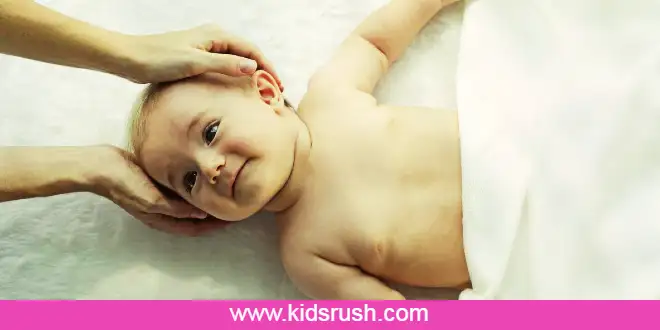For doctors, the flat head syndrome is more of a cosmetic problem than a health one. This abnormality is normally temporary and is present in a large number of babies at birth, or in the first months of life.
What is a flat head syndrome?
The flat head syndrome in babies, or plagiocephaly, is an abnormality in which the baby’s head becomes pointed, flat on the side, or back. This makes it look like a parallelogram and not round when viewed from above.
It is estimated that 20% of babies have this condition when they are in the womb or at birth. But, in most maximum cases, flat head syndrome presents in the first four to twelve weeks of life.
The flat head syndrome should rarely be a cause for concern. The baby does not feel any pain or discomfort and normally, everything returns to normal after a while. One in five babies has this condition.
Types of plagiocephaly

The flat head syndrome occurs in three forms. According to the cause and the shape of the skull, they are named as follows:
Deformation plagiocephaly. It is the most common way. It happens when the baby has a durable flat spot, either on the back or on the side of the head. Sometimes the forehead and face swell a bit on the side that is flat. [1]
Deformation brachycephaly. In this modality, the skull takes an almost round shape. The diameter of the upper part is nearly equal to that of the lower part. But, in some cases, the head takes a triangular shape. [2]
Scaphocephaly. In this case, the skull is long and narrow, oval in shape. It is a typical condition in premature babies. [3]
There is another variant of plagiocephaly: congenital. This is called craniosynostosis and is rare. In this case, the bones close prematurely and the malformation is not temporary, so it needs specialized care.
Discover: Obsessive Compulsive Disorder in Children: What is it and how to treat it?
Possible causes of the flat head syndrome
Plagiocephaly, or flat head syndrome, in common, is an outcome of sleeping posture, as the John Hopkins Hospital well points out. The bones of the baby’s skull are like puzzle pieces that change to allow the brain to grow. Therefore, they are also very malleable.
When a baby spends a lot of time lying down in the same position, they may get the flat head syndrome. However, the growth and development of the little one make, in a few months, everything normalizes.
Other causes of plagiocephaly include the following:
Multiple pregnancies. If there is more than one baby in the womb, the space in the uterus is reduced. Thus, there is an increased risk of the baby being compressed and developing plagiocephaly.
Preemies. Premature babies have much softer bones and spend much more time lying down during their stay in the hospital. This favors positional plagiocephaly.
Delivery with forceps or suction cup. These instruments can put pressure on the skull and cause deformity.
Muscular torticollis. It occurs when the baby has a small space in the belly and cannot move the neck and head easily. This causes stiffness or imbalance in the muscles in your neck and leads to cranial deformity. [4]
Associated signs and symptoms
The flat head syndrome is visible to the naked eye in some cases but is not so obvious in others. The most prominent symptom is the presence of a flattened area on the back, side, or front of the head. It is easier to detect during the bath when the baby’s hair is wet.
Other signs associated with this anomaly are the following:
- Absence of hair in one area of the head.
- The head looks as if it is tilted.
- One of the ears may be higher or further forward than the other.
If plagiocephaly is severe, it could be accompanied by other signs like these:
- Absence of soft spots on the baby’s head.
- Presence of hard edges or ridges on the skull.
- Facial abnormalities or asymmetry in facial features.
- Alterations in the normal growth of the baby’s head.
- Convulsions.
Treatments and recommendations for the flat head syndrome

Typically, a doctor will diagnose the flat head syndrome, including torticollis, through a physical examination. After that, it will indicate one of the following treatments.
Opposition therapy
This is the most popular treatment and has to do with varying the baby’s position when sleeping. Usually, the little one sleeps on his back, as this prevents Sudden Infant Death Syndrome (SIDS).
In this particular case, the doctor may find it advisable to change your posture from time to time. It is important to make the little one spend a few lapses face down, since this favors the correct formation of the head and also strengthens the neck muscles. In this position, the baby must always be supervised.
Exercises for a flat head syndrome in babies
Physiotherapy exercises are indicated for cases in which there is torticollis. The goal is to increase the range of motion of the neck, in particular through stretching of this area. This will also help your little one develop his motor skills.
It is very important that these exercises are done only on medical advice and strictly following the instructions. Otherwise, they could backfire.
Read Also: Walking Pneumonia in Kids: What You Need To Know?
Corrective helmet therapy
In some cases, helmets or headbands may be indicated to mold the baby’s skull. Such devices apply pressure to bulging areas while relieving pressure on other parts.
Typically, this type of treatment begins at 5 or 6 months of age. The baby must wear the helmet all day, except during the bath. However, there is no proof that this approach is useful. It could also cause skin irritation and even cause distress to the baby.
Surgery for a flat head syndrome in babies
Surgery is rarely required to treat postural flat head syndrome. It is usually reserved for congenital plagiocephaly only. The surgical intervention allows pressure to be released from the skull so that growth occurs in a normal way.
Does it represent any risk?
Most commonly, flat head syndrome resolves on its own over time. Babies grow and acquire new motor skills, so they take it upon themselves to change positions more often.
Postural plagiocephaly does not affect a child’s brain development. When it is accompanied by torticollis, it is important to do physical therapy, since the difficulty in the movement of the head can delay motor development.
Only 3.3% of children have flat head syndrome after 24 months of birth. Severe cases can compromise motor development. Only in the case of congenital plagiocephaly, surgical intervention is required to be corrected.
Read Also: Baby Drool Rash: Causes, And Treatment
When to go to the doctor
It is advisable to consult a doctor if signs or symptoms that may be associated with the flat head syndrome are detected. As noted above, this condition is seldom risky, but it always needs to be confirmed by your doctor.
In some cases, the head deformity is due to congenital plagiocephaly and this should be treated with a specialist. Likewise, some deformities are not due to posture as such, which is why it is necessary to rule out that there is any other condition.
Medical treatment is usually successful
Babies should always sleep on their backs, as this is the safest position for them. However, it is convenient to change their position from time to time and turn them upside down when they are awake. This is one way to prevent postural plagiocephaly.
The prognosis for babies with flat head syndrome is excellent. Most of them tend to improve markedly when they can sit alone. Even so, it is advisable to keep an eye on changes in the head and inform the doctor of any changes.
